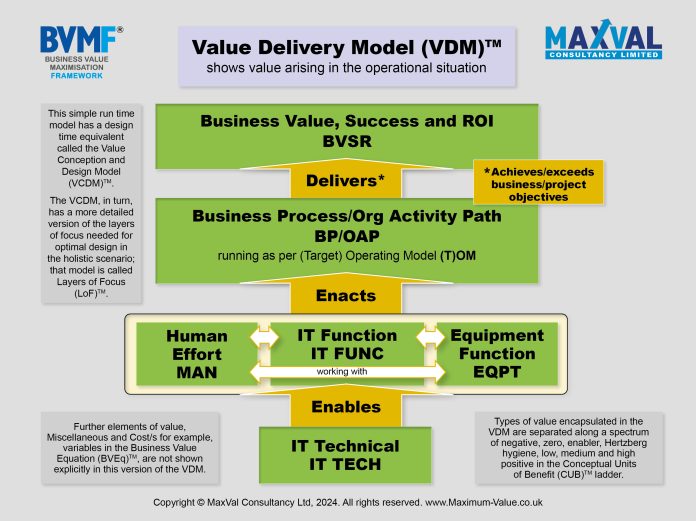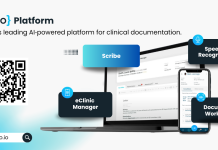David P Jacobs walks us through using the Value Delivery Model (VDM)™ to maximise success and return on investment
In my recent articles Seven Steps to Boost IT Business Value and Success! Part I and Part II, I outlined how to get ahead in the realisation of value, success and return on investment (ROI) when undertaking ‘digitally’ supported business/organisational projects and transformations.
Bearing in mind that the partial and complete failure rate of such projects has been 70% for the last 40 years, we need to focus on getting much better in this respect! I’ve run a research and development (R&D) programme on IT business value maximisation for the last three decades. This R&D has led to the development of the Business Value Maximisation Framework (BVMF®), which we at MaxVal Consultancy use to help client organisations.
Let’s now progress to more of the specific principles that can significantly help us go from 70% failure to 70% success!
Before we start a project or transformation
Before we start any project or transformation, a number of methods and/or approaches need to be identified and integrated. We need to blend a project management method (say Prince2 or PMBOK), an IT development approach/method (Agile, Waterfall, etc.), a Change method, IT service management (maybe ITSM) and, often, several other types of methods/approaches. The blend, however, has to be dependent on the nature of the intended project, the business environment, etc. So, which of these methods/approaches to use should not be the very first decision, as I’ve stated previously.
Persistently, unquestioningly using the ‘company standard method’ for X or Y will usually NOT be the most effective way to proceed. The blend of methods that will be most effective should be based on how the organisation works, the market it’s operating in, the organisational culture and a set of related issues. BVMF® offers a set of Landscape Value Characteristics (LVCs)™ to support this crucial method selection and integration, to blend methods into a coherent whole, specifically focused on getting the best results possible.
How value arises
To maximise value, success, and ROI, we need to understand how these three highly prized ‘commodities’ arise where we have business/organisational work processes supported by IT working together, collaboratively, with human beings. We then look at the elements we need to blend to get an optimum level of these value-related commodities. Finally, we need to consider how to go about the blending, taking into account the characteristics of each ‘value element’.
The value, success and ROI of a project or business as usual (BaU)/ continuous improvement (CI) initiative fundamentally arise from what is commonly known as the business process (BP) or organisational activity path (OAP), as I prefer to call it. IT certainly plays a part, but it’s a supporting part.
A good IT system will usually help, a bad one will hinder. Think of a golfer; to what extent does the quality of her/his golf clubs determine whether they will become a world champion? What determines whether the golfer wins or loses, becomes world-class or not, is the golfer’s skill and capability. So, more focus on the dog and less on the dog’s tail (sorry to switch metaphors) would help us reduce the persistent 70% global project failure rate.
The Value Delivery Model (VDM)™
Above is a simplified version of BVMF’s Value Delivery Model (VDM)™ to show these crucial relationships. The layers (green blocks) in this diagram are the elements to be blended together to gain maximum value. I cover how they are blended below.
In the diagram, is a simplified version of BVMF’s Value Delivery Model (VDM)™ to show these crucial relationships. The layers (green blocks) are the elements to be blended together to gain maximum value. I cover how they are blended below.
In the second green block down, we have the business process (BP/OAP) giving rise to the value, success and ROI. We then have the IT functionality (IT FUNC) working with the humans, highly collaboratively, I hope. It is the functionality at run-time of any IT system that helps human beings to do their work, not directly the technical layers of the IT (IT TECH) that, in turn, support IT FUNC.
The IT technicality is essential, yes, but it’s there to enable the IT functionality being a Hygiene factor in Frederick Hertzberg’s two-factor theory terminology. So, when IT is boosting (you hope) the power of your business process, it is the IT functionality doing it, as enabled (or sadly too often hindered) by the IT technicality; “Computer Says No!” said David Walliams. We also often have mechanical equipment in this layer (value recipe step) performing parts of the business process, increasingly software/IT driven electronically powered.
Value’s key elements
The enactment of the business process is a collaboration between human beings (MAN), the IT function (IT FUNC), and mechanical equipment (EQPT). This operational ‘football team’, as I call it, determines the degree of success that the business process achieves in addressing (or exceeding) the objectives of the project, department, organisation, etc.
So, the elements we blend together to get maximum value results (as cake recipe steps) are:
- The business process (BP)/ organisational activity path (OAP) in operational mode
- Human input/effort (MAN)
- IT function (IT FUNC)
- Equipment function (EQPT)
- IT technicality (IT TECH) – involves various sub-layers
There are other value elements potentially involved. However, these do not figure explicitly in this Value Delivery Model (VDM)™ as they are secondary.
Combining the elements
Given that the business process (BP/OAP) is enacted by combinations of its three elements: human effect (MAN), IT functionally (IT FUNC) and equipment function (EQPT) some of the valid combinations are:
- Human activity purely on its own, MAN
- IT functionality on its own – e.g. a batch process, IT FUNC
- IT assisted human activity – the most common combination in today’s workplace, e.g. a human being setting up an invoice using an IT system, MAN + IT FUNC
- Mechanical/electrical equipment like a clock, black box, IoT sensor, etc. combined with human and IT function, EQPT+ITFUNC+MAN
So, when IT is used to boost the power of a business process, the design of the IT functionality is crucial (as well as the effectiveness of the IT technicality) as it determines the degree of potential for that power. Many times, I’ve seen IT functional design as ‘just another line on the project manager’s plan’, and consequently, developers are not putting enough focus into the functionality being optimal for the end user, i.e. a human being! Of course, business analysts will usually drive the functional design even though such design is often constrained by the IT technicality, which in turn determines, at design and run time, how much of IT FUNC’s potential value comes through to help the business process in the operational situation.
To learn more:
MaxVal Consultancy will run a walk-in Business Value Maximisation Clinic at DigiGov Expo ’24 on September 24th and 25th and again at Government Transformation Week (4th-7th) on Nov 5th and 6th at the Intercontinental, London, O2.
The previous series of insightful articles by David P Jacobs (co-edited by MaxVal’s Philippa ‘Pip’ Randall-Nason) in Open Access Government can be found here.

This work is licensed under Creative Commons Attribution-NonCommercial-NoDerivatives 4.0 International.











